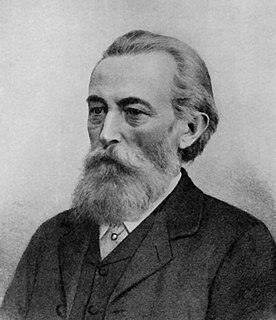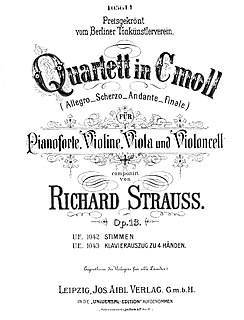
Johannes Brahms was a German composer, pianist, and conductor of the mid-Romantic period. Born in Hamburg into a Lutheran family, he spent much of his professional life in Vienna. He is sometimes grouped with Johann Sebastian Bach and Ludwig van Beethoven as one of the "Three Bs" of music, a comment originally made by the nineteenth-century conductor Hans von Bülow.

Sonata, in music, literally means a piece played as opposed to a cantata, a piece sung. The term evolved through the history of music, designating a variety of forms until the Classical era, when it took on increasing importance. Sonata is a vague term, with varying meanings depending on the context and time period. By the early 19th century, it came to represent a principle of composing large-scale works. It was applied to most instrumental genres and regarded—alongside the fugue—as one of two fundamental methods of organizing, interpreting and analyzing concert music. Though the musical style of sonatas has changed since the Classical era, most 20th- and 21st-century sonatas still maintain the same structure.
A piano trio is a group of piano and two other instruments, usually a violin and a cello, or a piece of music written for such a group. It is one of the most common forms found in classical chamber music. The term can also refer to a group of musicians who regularly play this repertoire together; for a number of well-known piano trios, see below.

Robert Fuchs was an Austrian composer and music teacher. As Professor of music theory at the Vienna Conservatory, Fuchs taught many notable composers, while he was himself a highly regarded composer in his lifetime.

The Cello Sonata No. 3 in A major, Op. 69, is the third of five cello sonatas by Ludwig van Beethoven. He composed it in 1807–08, during his productive middle period. It was first performed in 1809 by cellist Nikolaus Kraft and pianist Dorothea von Ertmann, a student of Beethoven. Published by Breitkopf & Härtel the same year, it was dedicated to Freiherr Ignaz von Gleichenstein, Beethoven's friend and an amateur cellist. The sonata was successful with audiences from the beginning.

Friedrich Gernsheim was a German composer, conductor and pianist.

Heinrich Picot de Peccaduc, Freiherr von Herzogenberg was an Austrian composer and conductor descended from a French aristocratic family.
Walter Rabl was a Viennese composer, conductor, and teacher of vocal music. Largely forgotten today, Rabl left only a small number of works, all of them early ones, from the twilight of the Romantic era. At the age of 30 he stopped composing entirely and devoted himself to conducting and vocal coaching the rest of his life.

Hans Gál OBE was an Austrian composer, pedagogue, musicologist, and author, who emigrated to the United Kingdom in 1938.
A clarinet-cello-piano trio is a clarinet trio made up of one clarinet, one cello, and one piano, or the name of a piece written for such a group.

Johannes Brahms composed his Piano Trio No. 2 in C Major, Op. 87, between 1880 and 1882. It is scored for piano, violin and cello. He wrote this piece at the age of 49.
The String Sextet No. 1 in B♭ major, Op. 18, was composed in 1860 by Johannes Brahms and premiered 20 October that year in Hanover by an ensemble led by Joseph Joachim. It was published in 1862 by the firm of Fritz Simrock.
The Clarinet Trio in A minor, Op. 114, is one of four chamber works composed by Johannes Brahms featuring the clarinet as a primary instrument. It was written in the summer of 1891 in Bad Ischl for the clarinettist Richard Mühlfeld and first performed privately on 24 November 1891 in Meiningen and publicly in Berlin on 12 December that year. It is considered by scholars as part of a rebirth for the composer who in 1890 declared his String Quintet in G major to be his final work.

Alexander Zemlinsky or Alexander von Zemlinsky was an Austrian composer, conductor, and teacher.

Carl Andreas Göpfert was a German virtuoso clarinettist, and composer. Göpfert composed in several genres, including symphonies, concerti, wind ensembles, sonatas, and songs.

The Three Romances for Oboe and Piano, Op. 94 is a composition by Robert Schumann, his only composition for oboe. It was composed in December 1849. The work consists of three short pieces in A-B-A form, and it was written during what was speculated to be one of Schumann's manic episodes.
The Trio for Piano, Clarinet and Cello in B-flat major, Op. 28, was composed by Ferdinand Ries in either Bonn in 1809 or Aachen in 1810 during the period he left Vienna to avoid being drafted into the Austrian army. It was published in 1811 by Simrock with a dedication to a Mademoiselle Clairette Ludwigs.

The Piano Quartet in C minor, Op. 13, TrV 137, was written by Richard Strauss from 1884 to 1885. An early chamber music work of the then 20-year-old composer, it shows considerable influence from Johannes Brahms. It is scored for a standard piano quartet consisting of a piano, violin, viola, and cello. At the premiere on 8 December 1885 in Weimar, Strauss himself performed the piano part.
Nicolai Pfeffer is a German clarinetist, music editor and adjunct professor at several music conservatories.












